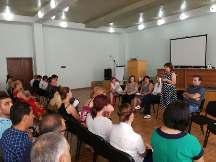
40 minute read
RESULT AREA 2: PARTICIPATION IN AND OVERSIGHT OF WATER RESOURCES ENSURED TO IMPROVE EFFICIENCY
The PURE Water project had planned to address the following issues:
Awareness-raising of target local governments of the BMO activities
Advertisement
BMO capacity building through public participation and information provision and exchange
Making BMOs more active and fostering cooperation with the basin communities‟ residents through presentation of
BMO daily activities, WUP issuance processes, and the measures implemented on the basin level.
ToT for BMOs to train and assist water users in using the water use permitting online platform developed and provided by the project to the RA MNP.
The project target communities were located in Ararat, Akhuryan or Hrazdan basin management areas. To promote cooperation between BMOs and project target communities, PURE Water project organized a series of introductory meetings between Ararat, Akhuryan and Hrazdan BMOs representatives (Annex RA 1-8). BMOs shared with local stakeholders the information on their day-to-day responsibilities and functions as regards each BMOs service areas, including rivers and natural lakes, and communities served as well as about the process of issuance of WUPs.
Based on the agreement with MNP, USAID-funded PURE Water and ASPIRED projects, within their mandates, committed to support MNP in improving e-governance and transparency, particularly, improve and upgrade water resource cadaster and create an opportunity for simplified on-line water-permitting.
PURE Water project particularly developed the simplified on-line water-permitting platform. The role of BMOs during operation of this system is important. They would be able to coordinate the process of WUP requests directly from their offices. Within the PURE Water project, BMO representatives‟ capacities were strengthened to assist the water users in the online application process. Water Use Permitting Platform User Manual has been developed to facilitate the practical use of the on-line platform.
Challenges and Recommendations
Challenges
Compared to the situation at the beginning of the project the level of activism and capacity of many residents in the target communities considerably increased, which can be attributed to PURE Water interventions. In spite of this, the majority of residents remain passive and not engaged. Overall, the level of civic engagement, voicing the problems and pursuing final solutions remain low due to prevailing traditional/cultural constraints, especially in rural communities, where it may not be “honorable” for men to publicly speak about the problem and criticize somebody and for women to participate in community discussions. As it was already mentioned, the Government Cabinet before the Velvet Revolution was not quite enthusiastic to follow-up on the implementation of the jointly developed Strategy and Road Map, although USAID has designed the project based on the Government priorities. The previous issue was resolved after the Velvet Revolution by the new Cabinet which was open and cooperative. However, high turnover of the leadership in partner ministries and agencies slowed down the relevant activities foreseen by the project work-plan. Good partnership with the RA NA Standing Committee and RA MTAI Water Committee resulted in the drafting of three legal documents. These units of executive and legislative bodies were ready to initiate the submission/circulation of the draft laws to the NA for approval, however, the constitutional amendments foreseen for March had shifted the Government priorities and resources to preparation and holding of the Referendum. The outbreak of COVID-19 pandemic and announcement of the state of emergency in the country halted the finalization of the legislative process under the project. BMOs were not quite enthusiastic and motivated to provide input for and learn from the project. According to the project observations, these were mainly because of the following reasons: - BMOs are understaffed to implement assigned responsibilities. Each of them has only 2-3 staff members each responsible for the water basin covering dozens of communities and large geographic areas.
BMOs still are under the pretty strong control of MNP. The discussions of PURE Water with MNP indicated that the WRMA mostly directly implements some functions of BMOs because they lack resources and capacity. In fact, the functions prescribed by the Water Code for BMOs actually were not fully granted to them and their role are limited to presenting the WRMA their observation on WUP applications and sending information about the situation. Communities within the BMOs service areas almost are not engaged in the decision-making process regarding water use permitting process and in basin management planning, in general.
Recommendations
The Government needs to further promote decentralization of water resource management, create conditions, and provide resources for BMOs to fully implement their functions as prescribed by the Water Code. BMOs capacities need to be improved to implement efficient basin management in their respective service areas. Civic engagement should be promoted in the course of the basin management process - starting from the development of basin management plans to the issuance of water use permits. The cooperation and coordination should be established between BMOs and communities located in their service areas to ensure wider transparency and participation in basin management of the service area. Follow-up the adoption of the Laws on Water Users Association, Ecological Policy, and Ecological Information by the RA National Assembly Assist WRMA in drafting amendments to RA Water Code and RA Government Decisions that regulate re-use and free use of water. Community activists, CBOs and CSOs, as well as development organizations need to make continuous efforts to entrench ownership and responsibility of citizens for the decisions taken in their communities through their direct participation. Continuous actions will mature over time civic activism and engagement and will turn them to habitual practices, behavior and culture.
RESULT AREA 2: PARTICIPATION IN AND OVERSIGHT OF WATER RESOURCES ENSURED TO IMPROVE EFFICIENCY
Pre-project situation: The Water Code recognizes the importance of public participation and awareness in the water resource management process, particularly, as regards to basin management planning, water permits, tariff strategy and water standards. The Code defines roles for civil society organizations and citizens in the protection of water resources and provides an opportunity to appeal decisions on water permits. Transparency and public participation are necessary especially during the process of issuing water use permits. Reports by USAID (2014) and World Bank (2015) stated that the permitting process was not quite streamlined and transparent. The application process took unjustifiably long due to huge bureaucracy. Potentially affected stakeholders did not have an opportunity to study any reports on the impact of the proposed application and the proposed permit conditions before the final decision. The Baseline Study conducted at the beginning of the PURE Water Project revealed that, only 4 percent of respondents participated in a training or discussion related to water resource management, water use, water quality/ access, or basin planning. Over 60 percent of water users in Ararat Valley did not trust WUAs, for the vast majority of them, the main sources of information were their co-citizens and local authorities. Community residents, including youth, local governments and CSOs were not motivated and skilled to initiate public monitoring of management and use of water resources.
The PURE Water project helped water users to acquire and apply creative public monitoring skills and tools with the engagement of youth, make the activities of WUAs as well as water use permitting process more transparent and streamlined.
2.1. Develop public oversight mechanisms
Achievements
Increased transparency and accountability are in place due to introduction of consumer feedback tools using information communications technologies
A simplified online water-use permitting platform for RօA Ministry of Environment is in place. A website/portal for Armavir WUA to increase awareness and simplify irrigation water requests is in place. A model upgraded MMIS for water problem raising and complaints is in place for Vedi municipality. A phone survey instrument is in place as an oversight and feedback tool for target communities.
A simplified online water-use permitting platform for RA MօE: The Government showed an exceptional willingness to simplify the water user permitting process and make it more transparent for water users and other stakeholders. During a meeting with USAID Mission Director, the Minister raised the need for online water use permitting platform.
Valuing the importance of addressing the problem the USAID asked PURE Water and ASPIRED projects to assist the Ministry in developing and operationalizing of the platform. For that purpose, the PURE Water, ASPIRED and the Simplified water permitting platform for the RA ME
Ministry signed a tripartite agreement on cooperation. The platform has already been developed by PURE Water experts. It has been officially tested and presented to the Ministry and other stakeholders. Now the Ministry is working on technical details to make it operational.
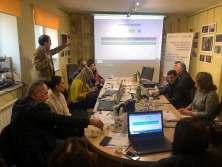
Once operated, not only Ararat Valley but also water users throughout Armenia will be able to apply for a water use permits or renew the existing ones directly from their computers without visiting the Ministry.
The project helped to conduct trainings for farmers, fish-farms, Training- Online water permitting platform WUAs, local governments and BMOs. The online user manual was prepared which clearly states the steps of applying and receiving the water use permit and hints water users how to submit their applications (Annex RA 2-13).

A website/portal for Armavir WUA to increase awareness and simplify irrigation water requests: WUAs are the irrigation water managers. They have been perceived by farmers as one of key stakeholders which takes responsibility for inefficient water management and use in Ararat Valley.
Their activities have not been considered transparent and participatory, whereas by their mandate they meant to express interests of water users and engage them in water governance.
The PURE Water project initiated a dialogue with WUAs engaging them in decisionmaking process at policy level (“Draft Law on WUAs”) and facilitating WUAs transparent practices in relation to their members – water users. Such an approach turned out to be fruitful. One of WUAs, Armavir WUA took a bold decision asking the project to help to develop a website for the organization. Following consultations and discussions with the Armavir WUA and the Water Committee, the young group of project experts developed the website: http://armavirwua.am/. The website included all decisions by WUA management bodies, the budget and expenditures of the WUA, the water sector legislation, the sector news, and other useful information for water users. The site also is an online platform for water users.
It provides an opportunity to submit an online request for irrigation water after calculating with a special calculator on the website the amount of the water needed for irrigation.
The website for Armavir WUAs
The Water Committee, as a state coordinator for a decent irrigation water supply for water users, was quite supportive in understanding the importance of having a website.
Based on the project advice, the Water Committee intends to further develop the Armavir WUA platform to connect it with the Committee database on expenditures and arrears of water users, so that each individual water user with its own personal account could enter and check his/her financial status. Such transparent practice will really increase the trust of water users toward the WUA. After the successful pilot, it officially requested the project to help to develop a similar website for all WUAs in Armenia.
A model upgraded MMIS for water problem raising and complaints for Vedi municipality: The Municipal Management Information System (MMIS) is an online platform established and developed by the GOAM with support from multiple donors including GIZ, USAID and others. MMIS serves the local governments across the country for their day-to-day administrative management as an intranet and as a municipal website. The Vedi Mayor
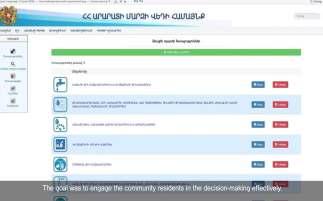

received regular applications and Upgraded MMIS of Vedi with a sub-section for water services complaints from community residents as regards different problems and emergencies in the drinking and irrigation water. As in other communities of Armenia, the residents used to come with all problems they face to the municipality, whereas in Vedi the addressing problem with drinking and irrigation water is not a municipal responsibility. Despite that fact, the Vedi Mayor always has tried to do his best to raise residents‟ cases with relevant authorities and service providers, which was not quite efficient in terms of using the Mayors busy time and solving the issue. The PURE Water helped the Vedi Municipality to upgrade the MMIS by developing a Water resources management subsystem and integrating it into the MMIS.
It made possible to register a variety of documents, service delivery procedures, the complaints by water users, etc. The system is linked to websites and information resources of sectorial organizations and agencies (Veolia Jur LLC, Public Services Regulatory Committee, MTAI/ Water Committee and MoH).
The municipal staff was trained to operate the system. The system has an opportunity for organizing online surveys, presenting media coverage (videos, pictures). Visitors of the site may disseminate the posted materials via social networks, leave comments. Water Portal User‟s Manual was developed and provided to all the respective parties (Annex RA 2-21).
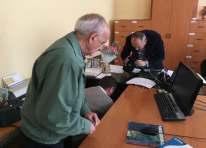

A phone survey instrument as an oversight and feedback tool for target municipalities. Another electronic instrument provided by the PURE Water project to target municipalities as an oversight and feedback tool was a computerized phone survey instrument. An introductory meeting was organized with the municipalities to present the electronic surveying tool to them. As a result, the phone survey instrument was installed in 10 municipalities: Vedi, Pokr Vedi, Burastan, Berkanush, Aygavan, Khachpar, Yeghegnut, Yeraskhahun, Aratashen and Guy.

The phone survey instrument allowed the municipalities to input
Installation of the phone survey instrument 8-10 questions on different aspects of drinking and irrigation water management and used. Then after the command, the computer randomly selects up to 400 phone numbers from the municipal database and makes calls. The call operator asks the questions to each respondent and ticks the bullets relevant to the answers. The system allows to prepare tables and charts and tables for reporting. After installation, PURE Water developed training modules and user manual and trained the municipal staff in 10 communities to use the phone survey instrument. All 10 municipalities conducted surveys to assess drinking and irrigation water supply services and also receive residents‟ feedback.
Residents in target communities are more vigilant and demanding due to community monitoring schemes for water quality and water efficiency
Local Government/Civil Society collaboration small grants. Citizen Scientists monitoring. A social audit by residents. Citizen Journalists‟ investigations.
Community/CSO small grants: Civil society in cooperation with local governments conducted monitoring of efficient management and use, as well as quality of water resources in Ararat and Armavir regions (Annex RA 2-9).
Monitoring to find out if drainage water is usable for irrigation (Yeraskhahun, Armavir marz): Huysi Metsamor CSO in cooperation with “Melioration” CJSC implemented monitoring of drainage water in Yeraskhahun community from September to December 2018 to identify if drainage water in Ararat Valley could be used for irrigation. Findings of the monitoring indicated that the drainage water in terms of quality and quantity could be used for irrigation purposes. Another success of the initiative was that the target municipalities, residents, as well as relevant state authorities were interested in the successful implementation of the monitoring and provided their assistance. Monitoring the quality of drinking water in Pokr Vedi by residents and civil society: Khor Virap NGO studied the materials of which the households‟ wells in Pokr Vedi community were made of to figure out to what extent the stored water meets the standards of drinking water quality. At the very beginning during their observations the NGO identified that part of water coming from the neighboring community to the village is passing through the broken pipes. Rapid public awareness activities were initiated and pipes were reconstructed. Khor Virap NGO also capacitated households
(including women and youth) on how to take drinking water samples from their wells. Youth volunteered to take drinking water samples from the households‟ wells. A survey was conducted with 100 residents of Pokr Vedi: 45 agreed to take water samples from their private wells.
SUCCESS STORY:
Cooperation between investigative journalists and communities
Partnership for quality drinking water and better irrigation services Monitoring to identify gaps for becoming a new Combining media coverage with monitoring activities increased the subscriber of Veolia Jur: Vedi community decided impact of the project the project. to monitor to what extent the water supply schedule complies with the one specified in the Legal Progress Union CSO monitored the compliance of the drinking subscribers‟ contracts and also what kind of price water quality supplied through pipes and sold from tanks with the Armenia standards in 3 communities of Armavir marz – Yeghegnut, quotes have been offered by Veolia Jur to different Miasnikyan and Noravan. The monitoring results of the Legal citizens for becoming a new subscriber. 10 case Progress Union project was provided to ALT telecasting, LLC. The studies were conducted on the challenges faced by Article was published covering the results provided by “Standard the residents while applying to Veolia Jur for Dialogue” expertise laboratory, which indicated that the quality of the water sold from the tanks does not correspond to the RA standards. becoming a new subscriber. The studies identified At the same time the article presented risks caused to human health there are not clear pricing policies for becoming a due to the incompliance of water quality with the established new drinking water subscriber. The findings have standards. been summarized in a brochure and discussed in a Hetq investigative journalists CSO monitored the water users‟ meeting between Vedi municipality, Veolia Jur and satisfaction of both drinking and irrigation water supply services in PURE Water held in the Infotun at Armavir Yeghegnut and Aratashen communities. The investigative journalists studied the water users‟ complaints on water user associations Development Center. (WUAs) services, identified and voiced about the water users‟ rights violations as well as recommended solution which relevant “Citizen Scientists” Actions: Young people from authorities never dealt with. Articles published in the course of the Ararat Valley and from other regions of Armenia monitoring are available here: were actively involved in the monitoring activities aiming at efficient management and use of ground https://hetq.am/hy/article/98712, https://hetq.am/hy/article/98648; https://hetq.am/hy/article/91631; water resources in Ararat Valley. Over 80 young https://hetq.am/hy/article/90526; people responded to the announcement of the https://hetq.am/hy/article/90410; PURE Water and submitted applications to https://hetq.am/hy/article/90128 . participate in the Idea Harvest, an idea contest (Annex RA 2-2). Young applicants received trainings in integrated water resource management, got familiar with the basics of drinking and irrigation water quality and its link to human health and the need for water saving. 40 young people were selected to participate in the Idea Harvest as “citizen scientists” (Annex RA 2-1). They formed small teams and through pitching exercise presented innovative solutions to the jury consisting of decision makers, donor representatives, and specialists. 4 teams received awards and implemented the following initiatives (Annex RA 2-3). USAID support was leveraged by the Global Coca-Cola Foundation:


Let’s drink efficiently: Cold drinking fountains are one of Armenia's visiting cards and are an integral part of the urban landscape. However, today there are two problems: careless flooding of water from the fountains and Mobile Application Presentation decreasing water loss. A group of resourceful “citizen scientists” representing ByoorAkn youth NGO proposed the “ByoorAkn” mobile application, which would allow a thirsty person to identify the nearest drinking fountain and show the direction to reach it. In order to use the water of the fountain more efficiently, as a pilot, in Vedi valves were placed on 3 drinking fountains allowing to make
fountaining stronger when drinking and weaker when getting away from it. This would save water 3-4 times without switching it off.
Trash Net: Cleaning irrigation water from waste: Innovation does not necessarily depend on high technological support. The project implemented in Pokr Vedi by a group of “citizen scientists” aimed to supply irrigation water to the community without any domestic, plastic or agricultural waste. The idea was to design and prepare “trash nets” which would be placed in irrigation canals and catch garbage thrown in the canals. The group closely cooperated with the active community members, engineers, waste management company, and Artashat WUA. The engineers supported to design the trash net, help in waste collection and removal. The innovative idea was piloted in one of the sections of Artashat canal which supplies irrigation water to Pokr Vedi and neighboring communities.
“Trap for Trash” in irrigation canals
Water Self-Governance: Concerned with the problem of efficient irrigation water management in Ararat Valley, the young people from Gyumri proposed to develop a website for Armavir WUA ( www.wuarmavir.am) that would allow water users to independently calculate the amount of needed and factually spent water (details are available at the beginning of the section 2.1.).
“Smart” Water-Metering System: The inefficient use of water resources, incomplete databases, lack of monitoring of the irrigation system, and the water-metering technical problems provoked this group of “citizen scientists” to think of making the whole system “smart.” To this end, they propose to install a water meter on the head of the land plot, the data of which will be Online water calculator inserted into a database through “smart” technology and become available on the mobile phone of the water user. As a result, the water user will pay for the actually spent volume of water. The water user will have to make a one-off payment for the water meter and equipment and become its owner. Alternatively, communities may become the owners and maintain the equipment. This equipment is mobile and may be easily operated even by non-professionals. The first trial of the pilot version took place in Yeraskhahun community with participation of Water Committee and community representatives (Annex RA 2-10).
Test trial in Yeraskhahun community
Monitoring by “Citizen Journalists”: “Citizen Journalists” had several roles in the PURE Water project: on one hand they had monitoring function – to identify, investigate groundwater related problems, collect information, on the other hand, they voiced these problems through different communication channels thus increasing awareness of groundwater problems in Ararat Valley.
They received a 3-day training by the Media Initiative Center which ran the USAID-funded “Media for Informed Civic Engagement” (MICE) project and cooperated with PURE Water project for this activity. The training was followed by on-site coaching and ongoing consultancy by a media professional. During the project, “citizen journalists” identified a number of problems in their communities. For instance, they identified, raised and investigated the problem of ambiguous procedures related to becoming a customer of the drinking water service provider. Some of their articles have been published in reputable newspapers (for instance, “Aravot” daily) and were posted in social media. The journalists covered the PURE Water key events, and interviewed relevant local and central authorities on different problems in water sector.
Below are some of the articles published by “citizen journalists” within the PURE Water project (Annex RA 21):
A tiny stream is offended
Orchards are watered with sewage water
An interview: the Ararat Regional Governor
An interview: the Pokr Vedi Community head
For Decades We Have Used More Water than Allowed –an interview with the head of Water Committee
An article about the drinking water problem in Aygavan community Investigation: how to become a drinking water customer? Ambiguous procedures.
A “Social Audit”: public monitoring of water managers/service providers budgets: Under PURE Water project, the community active groups, youth, local CSOs initiated “social audits” to raise transparency of local governments and WUAs in using public resources in water sector. Main targets for the “social audit” during the project life were expenditure, technical recordings, reports related to the community cost-share committed for small-scale infrastructure projects within the project, and expenditure of WUAs for the management and maintenance of irrigation system. The PURE Water project encouraged and created an enabling cooperative environment where community residents, CSOs as well as entities subject to “social audit” would feel comfortable to share information, experiences and ideas
SUCCESS STORY:
Citizen Journalists: Shining a Light on Water Management in Armenia (http://globalwater.org/)
“Mane Minasyan lives in Vedi, a small town in the heart of the Ararat Valley in the west of Armenia. At 19, she is raising awareness of groundwater depletion and prompting behavior change in her community. Mane received her investigative journalism training from USAID‟s Participatory Utilization and Resources Efficiency of Water (PURE Water) project, which is working to increase water productivity, efficiency, and quality in the Ararat Valley by enhancing citizen participation in water resources management. PURE Water-trained citizen journalists are empowered to investigate groundwater-related issues and voice these problems through various communication channels. To date, the project has trained 51 citizen journalists in four communities who have published more than 50 articles, reaching nearly 1,700 Armenians. Mane‟s work is an example of how this training has directly contributed to improving water management in one such community (http://globalwater.org/)
“Mane explains that thanks to support from PURE Water, the people of Vedi “know there‟s a journalist in their community,” which has contributed to improved water management on the part of the town‟s municipal leadership. She has also inspired action among town residents. “Before, people might see an issue and just complain about it,” Mane says. “Now, they see an issue, take a picture, and send it to me. I post it on the municipality‟s webpage, and there‟s a response in 15 minutes or less.” (http://globalwater.org/)
Mane Minasyan (left) in “citizen journalists‟” training
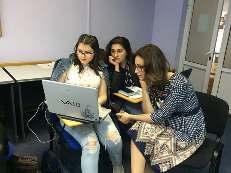
Due to the success in identifying and covering the water sector problems in Ararat Valley under the PURE Water project, Mane was given an opportunity have an internship in Hetq a famous online investigative journalism media in Armenia. She has already established an NGO to promote addressing different community issues.
with each other. 5 target communities - Aratashen, Yeraskhahun, Yeghegnut, Vedi and Pokr Vedi and Armavir WUA were included in the process of social audit. After the “Participatory Monitoring and Social Audit” training attended by the representatives of target communities residents local governments, the WUA and local CSOs, the social auditor teams identified the subject and scope of the social audit. The list included journals of water distributors, spending of collected revenues for irrigation by Armavir WUA, reports of the WUA about the maintenance of the networks, cost-share documents for small-scale infrastructure projects by target communities.
The social auditors came up with the 2 methods to conduct “social audit:” 1) conduct it in the offices of local governments and the WUA and 2) preparation and presentation of a report to public by local governments and WUA based on the scope of the request submitted by the social auditors‟ teams.
After conducting the social audit in 5 communities and in Armavir WUAs Social Audit Reports (Annex RA 2-16) have been prepared and presented to the residents of target communities.
SUCCESS STORY:
Transparent Water Governance: Armavir WUA opens-up its financial and technical records for social auditing by water users
Armavir WUA, providing irrigation water services for many communities in Armavir region and particularly some of the project target communities, demonstrated a unique commitment to be more open and transparent to its main constituents – irrigation water users, with the support of the PURE Water project.
The WUA willingly accepted the suggestion by the PURE Water project to be included in the process of social audit arranged by the active water users of target communities. The cooperative approach of social audit adopted by the project further encouraged the WUAs to put a confidence in the auditing process.

The WUA was invited to trainings for active water users - “social auditors.” The “social auditors” were provided with knowledge on WUA‟s financial flows, budget monitoring and audit implementation mechanisms, as well as got skills on budget auditing tools, such as analyzing the budgets and mapping the projects criteria. After the training, the “social audit” team requested the budget of the “Armavir” WUA, conducted the audit and prepared a Social Audit Report. The report was shared with the WUAs and jointly presented to communities‟ residents during the public hearings. The participants shared their perspectives on further use of social audit tools in their communities.
The PURE Water Project team conducted a number of water monitoring Social Audit training activities in the partner communities. Such open governance practice served as a stimulus for “Armavir” WUA to ask for another support from PURE Water project in developing a website (the first The water monitoring activities aimed at ever for any WUA in Armenia) were all financial and technical information of the enhancing the level of public awareness WUA would be available. Currently, this request and commitment also became to and participation (particularly by the reality: www.armavirwua.am . youth and women) in the preservation of water resources and in the base monitoring of water resources in their communities.
The monitoring activities consisted of two stages: educational seminars/community meetings and field works.
For field works, the project team procured Water Test Education Kits offered by the American LAMOTTE company, and were widely used during water monitoring trainings with schoolchildren, teachers, and young activists. Water Test Education Kit allows to immediately assess the content of pH, dissolved oxygen, nitrates, and phosphates coliform

bacteria in the water, water turbidity LAMOTTE water monitoring educational tool kits and temperature. The teachers and schoolchildren tested the presence and content of chlorine in the drinking water using the Test Kit as well as quality of outgoing water of fish-farms (Annex RA 2-11).
2.2.
Build capacities of community stakeholder through target capacity building activities in the use of public oversight mechanisms to monitor water quality and quantity, usage and basin planning and management.
Capacity building was one of the key components of the PURE Water project. The baseline study revealed that before the project only 4% of the residents in Ararat Valley participated in training or discussion related to water resource management, water use, water quality/access, or basin planning. The training and seminar participants‟ age-group varied from 46-75 years. Surprisingly and sadly, youth didn‟t participate at all. As mentioned before, the baseline in Ararat Valley also showed a very low citizen participation (around 5%) in decision-making regarding water problems. Poor capacity was one of the key reasons for low civic engagement.
Therefore, the project had a challenging task to build capacities of all community stakeholders, especially youth, to promote their involvement in advocacy, monitoring, efficient management and use of water resources. Capacity building activities included environmental trainings, seminars with a focus on water resources for youth and schoolchildren, community residents, and target local governments as well as special trainings to capacitate stakeholders in using different advocacy, oversight and feedback tools provided under the project.
Achievements
Stakeholders of target communities, including schoolchildren, youth, and women, are better educated and aware of water issues, as well as of their water rights, and protection mechanisms
Environmental education for the teachers and schoolchildren of target communities. Eco camp and Eco clubs for schoolchildren. Environmental seminars for community residents. Educational and public information materials.
2000 Public information materials delivered Overview: Ararat Valley Water Resources; Q&A drinking and irrigation water; Citizen participation; Water Users Rights and Responsibilities; Water Directory, Best practices of fish farms, desktop calendar, bookmarks for children
Environmental education for the teachers and schoolchildren of target SUCCESS STORY: communities: The PURE Water partnered Vedi School Student Narek Ohanyan with Armenia Tree Project (ATP) to carry Voiced the Ararat Valley Groundwater Problem during the out educational activities for schoolchildren Environmental Education Network meeting at UN in partner communities as a part of public Following the series of events mentioned above, Narek Ohanyan from Vedi education and awareness campaign. The #2 Basic School, who had performed very well and made an impressive goal was to change the schoolchildren presentation during the study tours on the topic of water, got an opportunity behavior and increase understanding with to make a presentation at Environmental Education Network meeting at UN regard to efficient water management and Conference hall in Yerevan. His presentation covered a wide range of issues use. related to water and included topics such as Ararat Valley artesian basin, groundwater resources, inefficient use and management of water, water Training of trainers (ToT) was conducted footprint, and tips on saving water. He also presented what activities have by ATP for Ararat and Armavir regions 22 been implemented so far in the framework of PURE Water project. teachers of environment, biology and chemistry to increase their knowledge on environmental and health issues related to the management and use of the Ararat Valley water resources. The teachers were provided with "educational tools" and were introduced to techniques that would make the presentation process of the problem more interesting and effective for their schools. Experts from USAID-funded Partnership for Enhanced Engagement in Research/Sustainable Fisheries for Narek's Presentation, UN. Enhanced Water Resources in Armenia (PEER / SFEWRA) and the ASPIRED projects contributed to the training with presentations on "Ararat Artesian Basin and Groundwater" and "Water Saving Technologies (Annex RA 2-15).


Equipped with additional knowledge and skills the teachers conducted environmental classes for the schoolchildren of all 12 schools in project target communities using a Handbook for School teachers developed and provided by the project.
In-school classes were combined with practical exercises and educational tours to fisheries, artesian water basin in Aknalitch community, and Karin nursery (Annex RA 2-18). In fisheries the schoolchildren learned how fisheries were functioning, got familiar with the best practices of some fish farms in applying groundwater saving technologies. Concerned with the issue of depletion of groundwater resources they jointly put together a letter to the large fisheries calling them to save the scarce groundwater resource and apply water-saving technologies. The letter was published and further disseminated by a reputable
Hetq online media (A Letter to Large Fisheries by the Schoolchildren from Ararat Valley). The teachers capacitated by the PURE Water project experts tested the quality of the water incoming to and outgoing from the fishery pond by using the water monitoring toolkits acquired by the project and donated to the school laboratories. During the visit to the Aknalitch Lake schoolchildren learned how it is fed as an ecosystem, they learned about the
Ararat Valley groundwater problems and practiced out water tests using the tools provided by the project. In Karin tree nursery the students learned about drip irrigation and saw how it worked in reality.
Eco camp and eco clubs for target community schoolchildren: A two-day Eco Camp was organized at “Machanents” House in Vagharshapat for schoolchildren of the project partner communities from Ararat and Armavir
marzes. The schoolchildren were selected based on active participation in specialized courses and study tours organized in their schools in recent months and excellent academic performance. The campers combined learning with active games and performances, preparing to set up eco-clubs in their schools. After the camp, the schools participated in creation of messages to be included on the posters as 10 commandments for efficient water management and use. (Annex RA 2-14). The best and most relevant messages were selected and the poster and leaflets have been printed for distribution among the schools. Three schools were selected to host eco-clubs at their schools. Vedi, Yeraskhahun, and Baghramyan schools where the schoolchildren of Berkanush and Burastan target communities attend. The ecoclubs should develop their annual action plans and implement them to participate in an annual performance award nomination by ATP.
Thematic environmental seminars for community residents: PURE Water conducted series of environmental seminars and training for the target communities‟ residents, including youth and women, as well as for local governments. The training seminar topics included: Integrated Water Resource Management (Annexes RA 2-27; 2-26; 2-19; 2-20; 2-24) Water Quantity and Quality Monitoring (Annex RA 2-23) Water and Health (Annex RA 2-22) Drinking Water disinfection (Annex RA 2-6) Citizen Participation (Annex RA 2-25):
Special trainings for efficient water management and monitoring skills Water Monitoring training: testing groundwater quality Water Monitoring training: “citizen scientists” to have basic knowledge to propose innovative water monitoring ideas Water Monitoring training: citizen journalists” to identify and voice groundwater problems in the target communities Participatory budgeting Social Audit Phone survey instrument: how to conduct survey and analyse results using the tool installed in target communities Project design and management
In the course of the aforementioned capacity building activities the target community stakeholders acquired knowledge and skills on the principles of integrated water resource management and protection mechanisms, the concept of a watershed, the economic value of water, the role of public advisory councils adjacent to territorial water-basin management bodies, mechanisms of implementation of water monitoring and monitoring bodies, water-born diseases and their prevention, water quality, drinking water disinfection methods, importance and tools of civic engagement in decision-making process related to water issues, etc.
Apart from general knowledge on water resources, water management and monitoring special trainings were conducted for community stakeholders to provide them hands-on skills in practical monitoring water quality and service provision. The stakeholders gained the skills on how to identify and prioritize water sector problems, how to put together a project proposal for small-scale water infrastructure project, how to launch participatory budgeting process and organize public hearings, conduct social audit of the budgets of local governments and water user associations, how to conduct water tests on drinking, irrigation and fish-farm ponds water quality, the quantity of the residual chlorine in water as compared with the standard, , how to use phone survey instrument to get citizen feedback on water services, how young “citizen journalists” could identify, voice and disseminate information about the problems in water sector in their communities, etc.
Educational materials: Capacity building activities were accompanied with provision of additional thematic reading –educational materials, handouts, relevant information for increasing the community residents and citizens‟ awareness and knowledge on a wide range of water issues and best practices. Some of the provided educational materials were:
The Climate Change hand-out (Annex RA 2-5): describes the threats and challenges related to climate change, as well as the main man-made causes of climate change, differences between climate and weather, the overall
principles of global warming, occurrence and accumulation of greenhouse gases, and their effect on climate change, etc. Water Monitoring information leaflet: describes the mechanisms for drinking and irrigation water, as well as the contacts of the organizations responsible for monitoring in the RA (Annex RA 2-23). A Vision of Gender. What is this?” and Gender, Water, Sanitation and Health thematic booklets (Annex RA 2-7): (Armenian version) by Armenian Ziraldo Cartoon, the Gender and Water Alliance. Water and Health information leaflet (Annex RA 2-8) describes the importance of drinking water for life, pollution sources of drinking water, water-borne diseases and their prevention (Armenian version). Drinking water disinfection methods information leaflet (Annex RA 2-6).
2․3․ Assist local governments in affected communities to ensure compliance of the local users with the updated regulatory framework and transparency, ensure community members engagement in water-related decision-making public access to water-related information
Achievements
Residents in target communities are mobilized and actively participate in community life
Residents of target communities were engaged and identified problems in water sector in their communities Target local governments were involved and provided input forging the strategic policy and regulatory approaches toward participatory management and use of groundwater resources. Target local governments and community working groups mastered the methodology of prioritizing the identified problems. Target local governments are able to design and monitor water infrastructure projects. Target community budgets are formed and expenditures reported through participatory budgeting and annual budget hearings. Target local governments are more open to the process of social auditing of community expenditures.
The PURE Water has closely cooperated with local governments in target communities. Technical assistance has been provided to help them mobilize community residents for learning about and prioritization of the issues in water resource management. Local governments were engaged in developing strategic approaches towards participatory water management, local staff mastered using several tools to mobilize and engage community residents: phone survey instrument, participatory budgeting process, regular public hearing, designing and developing project proposals. Below is a brief description about how each of those tools has been practically applied in the project (Annex RA 2-12): Town-hall meetings: Regular town-hall meetings have been conducted by 12 target communities. - Identifying and prioritizing small scale water infrastructure projects: The residents have selected community working groups (CWG), which were acting on their behalf to prioritize the problems in drinking and irrigation water sectors identified by the residents. CWGs were trained to use a special Delphi methodology to prioritise the water sector problems. Weighting and scoring approaches have been used for each criterion (financial, environmental, beneficiary coverage, social support) to make the prioritization more balanced. Guidelines and tools for
Town-hall meeting in Vedi participatory strategic planning was developed and
provided for target communities. - Monitoring of implementation of small scale infrastructure projects: town hall meetings (midterm and final) were conducted to by target local government to report to the residents of Yeghegnut,Yeraskhahun, Vedi,
P.Vedi and Khachpar about the process and the findings identified during the public monitoring of the water infrastructure projects. Designing and monitoring small-scale infrastructure projects: a special training has been conducted for the municipal staff of the target local governments to design, develop and monitor small-scale water infrastructure projects. Also, mentoring and coaching was conducted by the project staff to help communities finalize and submit the proposals. Engagement in developing the Strategy and Road map: target local governments were directly engaged in the process of discussion of key strategic approaches of the Strategy and the Road map aiming to improve policy and regulatory framework to promote civic engagement in water sector. Such direct involvement generated a sense of ownership to raise community residents‟ awareness on improved policies and regulations and to apply them at local level. Participatory budgeting: Practicing participatory budgeting was a new culture for PURE Water target community residents. For the first time, the residents of all 12 communities have direct input in development of the community budgets. During the community meetings, priority water projects identified by the residents were presented by local governments with corresponding estimated costs for implementation and commitments were made to the residents to include the amount of community cost-share for water infrastructure projects, as well as costs of citizen participation Public hearing in the community budgets. The important outcome of this process was that during the development of the next year‟s budget, seven target local governments independently initiated the participatory budgeting process without the support of the PURE Water project. Public hearings: target local governments also organized a series of public hearings to report to the public on the anticipated expenditures and revenues (including property tax, land tax, rent and wastewater collection) planned under the budget as to introduce the expenditures for water sector improvement in the communities. The PURE Water project helped the Aratashen community to organize a public hearing on water meter installation in the scope of the infrastructure project. The community head and staff reported to the residents about the costs needed to purchase and install water meters, why it is necessary to install them, and for what purposes the collected revenues from the used drinking water by the residents will be spent by the community. Social Audit: 5 target local governments - Aratashen, Yeraskhahun, Yeghegnut, Vedi and Pokr Vedi - opened-up their budgets to the review of community social auditing groups. Findings of the reports have been presented to the community residents by the social audit teams and municipal administration. Phone Survey instrument: this tool provided by the project was mastered and used regularly by the municipal staff to identify from the residents on water problems and learn their feedback about the improvements made by the municipality.
Challenges and Recommendations
Challenges Low participation culture: Although the PURE Water project considerably promoted civic engagement in water sector decision-making civic participation in general remains weak, sometimes alien to many residents and some local governments. Only half of target local governments demonstrated commitment to go through the complete participatory process proposed by the PURE Water project. 3 target local governments became less interested in the project already in the first project year. The projects “participatory mandate” seemed to be too heavy for them.
They did not apply event for small-scale water infrastructure projects. 2 local governments gradually decreased their involvement since their applications for infrastructure projects were not successful. So, it turned out that they were involved in the project mostly for getting an infrastructure projects. However, the cooperation has been continued with schools and community activists. 5 communities with infrastructure projects as well as 2 communities without infrastructure projects were actively involved in the project from the beginning till the end. The baseline study showed no earlier participation by youth. The PURE Water project improved the situation.
Young generation from target communities actively participated in the project activities. However, youth participation still remained low as compared with the age group from 45-75. Simplified water use permitting platform is one of the achievements of the PURE Water project and is a result of the exceptional commitment of the RA Minister of Environment to make the permitting process open and transparent and the result of effective partnership between the project and the government which turned that commitment into reality. At the closure of the project, there were some remaining technical/administrative difficulties to make the platform operational. These challenges were outside the PURE Water control and only partially under the control of the ME. The issue is within the Government and is believed to be addressed soon. COVID-19: the installation of smart meters by “citizen scientists” was put on hold because of the pandemic, but all stakeholders are committed to install them as soon as possible.
Recommendations Transparent, open, participatory, and accountable governance in water sector should be a continuous process and needs to be pursued after the project by all stakeholder to become a habitual behavior and culture: • RA Ministry of Environment needs to deal with the technical problems with regard to the online water use permitting platform and operationalize it to ensure a transparent, streamlined and simplified permitting process. • Relevant authorities need take over and replicate the models piloted under the PURE Water project to ensure open and transparent water management, efficient irrigation and drinking water supply, better water quality, fair water distribution, particularly: trash-net (Water Committee, WUAs, communities), WUAs websites (Water Committee, WUAs), smart meters (Water Committee, WUAs, communities), improved infrastructure with water saving technologies (Water Committee, WUAs, communities), water sector subsystem added to MMIS (RA MTAI, communities). • Target local governments need to continue practicing management, oversight and feedback mechanisms provided under the PURE Water project: participatory budgeting, phone surveying, public hearings, problem identification methodology, etc. • Community-based NGOs, water sector and environmental NGOs need to continue working with local community activists and together with them continue to voice and advocate water sector related problems using different tools mastered within the PURE Water project: town-halls, social audit, “citizen scientists”/idea contest, citizen journalists, etc. • Schools need to continue environmental education combined with practicum in the field using relevant devices provided to them by the project. They need to share their knowledge and skills with other schools in and outside Ararat Valley. Three schools with eco-clubs need to make some efforts to make them sustainable centers of environmental education by keeping the partnership with the Urban Foundation, ATP and other environmental CSOs.



